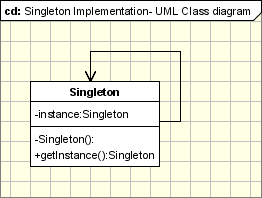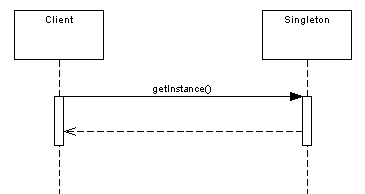Singleton design pattern in Java, Kotlin, Python and Swift Development 14.09.2016
Creational Design Patterns provide solution to instantiate an object in the best possible way for specific situations. Following design patterns come under this category.
Singleton pattern ensures that only one object of a particular class is ever created.
Sometimes it’s important for some classes to have exactly one instance. There are many objects we only need one instance of them and if we, instantiate more than one, we’ll run into all sorts of problems like incorrect program behavior, overuse of resources, or inconsistent results.
Usually singletons are used for centralized management of internal or external resources and they provide a global point of access to themselves.
There are only two points in the definition of a singleton design pattern:
- There should be only one instance allowed for a class.
- We should allow global point of access to that single instance.
This sequence diagram shows how simple it is for a client to get an instance of the Singleton.
Usage of Singleton design pattern:
- Singleton pattern is mostly used for memory save because object is not created at each request. Only single instance is reused again and again.
Java
// file Singleton.java
class Singleton {
private static Singleton instance;
private Singleton() {}
public static synchronized Singleton getInstance() {
if (instance == null)
instance = new Singleton();
return instance;
}
public void doSomething() {
System.out.println("Singleton");
}
// serialization
protected Object readResolve() {
return getInstance();
}
}
// file Demo.java
public class Demo {
public static void main(String[] args) {
Singleton object = Singleton.getInstance();
object.doSomething();
}
}
Python 3
Create Singleton using metaclass.
class SingletonType(type):
instance = None
def __call__(cls, *args, **kw):
if not cls.instance:
cls.instance = super(SingletonType, cls).__call__(*args, **kw)
return cls.instance
class Singleton(object):
__metaclass__ = SingletonType
def do_something(self):
print('Singleton')
s = Singleton()
s.do_something()
Kotlin
Kotlin just introduces a reserved keyword for that. Behold, an object as follows:
object MySingelton{}
You don't need curly brackets there. They're just for visual consistency. This combines declaration and initialization in one keyword. From now on, MySingleton can be accessed from anywhere in your code, and there'll be exactly one instance of it.
Of course, this object doesn't do anything interesting. Let's make it count the number of invocations instead:
object CounterSingleton {
private val counter = AtomicInteger(0)
fun increment() = counter.incrementAndGet()
}
For now, we test it only to see how we call our Singleton:
for (i in 1..10) {
println(CounterSingleton.increment())
}
This will print numbers between 1 and 10, as expected. As you can see, we don't need the getInstance() method at all.
Objects can't have constructors. If you want some kind of initialization logic for your Singleton, such as loading data from the database or over the network for the first time, you can use the init block instead:
object CounterSingleton {
init {
println("I was accessed for the first time")
}
// More code goes here
}
It is also demonstrated that Singletons in Kotlin are initialized lazily, and not eagerly, as some could suspect from the ease of their declaration. Just like regular classes, objects can extend other classes and implement interfaces.
Swift
Let's look at how we implement the singleton pattern with Swift. The following code example shows how to create a singleton class:
class MySingleton {
static let sharedInstance = MySingleton()
var number = 0
private init() {}
}
We can see that, within the MySingleton class, we created a static constant named sharedInstance, which contains an instance of the MySingleton class. A static constant can be called without having to instantiate the class. Since we declared the sharedInstance constant static, only one instance will exist throughout the lifecycle of the application, thereby creating the singleton pattern.
We also created the private initiator that will restrict other code from creating another instance of the MySingleton class.
Now, let's see how this pattern works. The MySingleton pattern has another property, named number, which is an integer. We will monitor how this property changes as we use the sharedInstance property to create multiple variables of the MySingleton type, as shown in the following code:
var singleA = MySingleton.sharedInstance var singleB = MySingleton.sharedInstance var singleC = MySingleton.sharedInstance singleB.number = 2 print(singleA.number) print(singleB.number) print(singleC.number) singleC.number = 3 print(singleA.number) print(singleB.number) print(singleC.number)
In this example, we implemented the singleton pattern using a reference (class) type because we wanted to ensure that only one instance of the type existed throughout the application. If we implemented this pattern with a value type, such as a structure or an enumeration, we would run the risk of there being multiple instances of the type. If you recall, each time we pass an instance of a value type, we are actually passing a copy of that instance, which means that, if we implemented the singleton pattern with a value type, each time we called the sharedInstance property we would receive a new copy, which would effectively break the singleton pattern.
Quote
Categories
- Android
- AngularJS
- Databases
- Development
- Django
- iOS
- Java
- JavaScript
- LaTex
- Linux
- Meteor JS
- Python
- Science
Archive ↓
- December 2023
- November 2023
- October 2023
- March 2022
- February 2022
- January 2022
- July 2021
- June 2021
- May 2021
- April 2021
- August 2020
- July 2020
- May 2020
- April 2020
- March 2020
- February 2020
- January 2020
- December 2019
- November 2019
- October 2019
- September 2019
- August 2019
- July 2019
- February 2019
- January 2019
- December 2018
- November 2018
- August 2018
- July 2018
- June 2018
- May 2018
- April 2018
- March 2018
- February 2018
- January 2018
- December 2017
- November 2017
- October 2017
- September 2017
- August 2017
- July 2017
- June 2017
- May 2017
- April 2017
- March 2017
- February 2017
- January 2017
- December 2016
- November 2016
- October 2016
- September 2016
- August 2016
- July 2016
- June 2016
- May 2016
- April 2016
- March 2016
- February 2016
- January 2016
- December 2015
- November 2015
- October 2015
- September 2015
- August 2015
- July 2015
- June 2015
- February 2015
- January 2015
- December 2014
- November 2014
- October 2014
- September 2014
- August 2014
- July 2014
- June 2014
- May 2014
- April 2014
- March 2014
- February 2014
- January 2014
- December 2013
- November 2013
- October 2013

